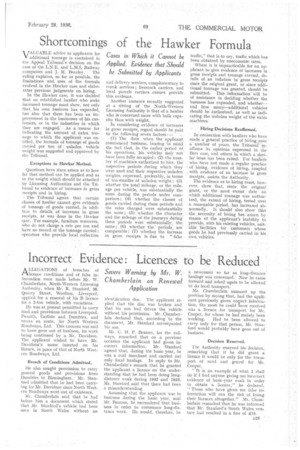Shortcomings of the Hawker Formula
Page 39

If you've noticed an error in this article please click here to report it so we can fix it.
VALUABLE advice to' applicants for V additional tonnage is contained in the Appeal Tribunal's decision on the case of the L.N.E. and L.M.S. Railway companies and J. M. Beazleb. The ruling explains, so far as possible, the limitations and uses of the formula evolved in the _Hawker case and elaborates previous judgments on hiring.
In the Hawker case, it was decided that an established haulier, who seeks increased tonnage must show, not only that., his own business has expanded, hut also that there has been an. improvement in the businesses of his custhniers, or in the industries in which they arc engaged. As a means for indicating the amount of extra tonnage to which the applicant was entitled, the formula of tonnage of goods carried per ton of . unladen vehicle weight' was suggested and approved by the Tribunal.
Exceptions to Hawker Method.
Questions have since arisen as to how far that method can be applied and as to the weight which should be attached by Licensing Authorities and the Tribunal to evidence of increase a in gross receipts and in hiring.
The Tribunal agrees that certain classes of haulier cannot give evidenCe of tonnage of goods carried, in additie.ai to details of. increases in gross receipts, as was done in the Hawker case. For example, furniture removers, who do not charge a rate per ton and have no record of the tonnage carried; operators who provide local collection and delivery services, complementary to trunk services; livestock carriers, and local parcels carriers cannot provide. this evidence.
Another instance recently suggested at a sitting of the North-Western Licensing Authority is that of a haulier who is concerned more with bulk capacity than with weight._ In conaidering evidence of increases in gross receipts, regard should be paid' to the following seven factors:— .
(1) The date when the applicant commenced business, bearing in mind' the fact that, in the earlier. period of his operations, his vehiCles nia'Y not have been fully occupied; (2) the number of machines authorized to -him, the respective periods during which they were used and their respective unladen weights, expressed, preferably, in terms of ton-months of unladen weight ; (3) whether the total mileage, or the mileage per vehicle, was substantially the same during the periods under corn-. parison; (4) whether the classes of goods carried during these periods and the rates charged were substantially the same ; (5) -whether the character. and the mileage of the journeys during. these periods were substantialIy., . the, same ;s (6) whether the ' periods are comparable; _(7) whether the increase. in gross receipts is due to " false
traffic," that is to say, traffic which has been obtained by uneconomic rates.
Where it is impracticable for an applicant to give evidence of increases in gross receipt's and tonnage carried, details of an inflation in gross receipts since the original grant, or since additional tonnage was granted, should he, submitted. This :information will be of assistance in deciding Whether the business has expanded, and whether— and how nia.ny—additional vehicles should be authorized, as well as indicating-the unladen weight of the extra machines.
HiringDecisions Reaffirmed.
In cdnnection with hauliers who have made a general practice of hiring over. a number of years, the Tribunal: reaffirms its opinions expressed in the Barr case, and others in which a sing-,
• lar issue has been raiSed. For hauliers who have not made a regular practice of hiring, evidence of hiring, coupled with evidence of an increase in gross receipts, assists the Authority.
The evidence as to hiring must, however, show that, since the original grant, or the most recent date ' on which additional tonnage was authorized, the extent of hiring, tested over a reasonable period, has increased abnormally. It should also show that the necessity of hiring has arisen by , reason of the applicant's inability to provide, with his existing vehicles, suitable 'facilities for customers whose goods he had previonslY carried iri his'. own vehicles.




























































































